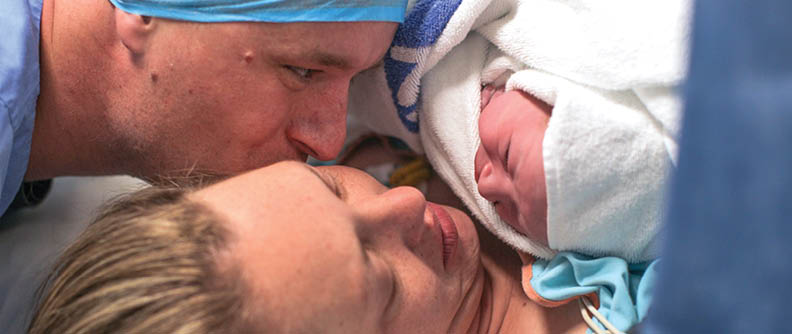In most situations, vaginal birth is safest for both mother and baby. However, in some cases, a Cesarean birth (C-section) is the best choice.
What is a Cesarean birth?
A Cesarean birth is major abdominal surgery. During the procedure, your clinician makes incisions in your abdomen and uterus and then helps the baby be born. Before the surgery, most people receive a spinal block, which is very strong pain medication used to numb you from the top of your abdomen to your toes.
Our team of highly qualified clinicians are trained to provide you with the best care during a Cesarean birth. You’ll still be awake during the procedure, and you’ll probably feel movement or pressure as your baby comes into the world. If you have questions, we’d love to answer them. Please talk with your care team about any concerns you may have.
Reasons for a Cesarean birth
Sometimes, C-sections are planned in advance, and others your clinician might determine that you need the procedure while you’re in labor.
You may have a Cesarean birth if:
- Structural issues in your uterus or complications resulting from previous surgery make a C-section the safer choice.
- The placenta partially or fully covers your cervix.
- The baby is in a position other than head-down (called a breech position).
- There are active herpes lesions inside the vagina, which can infect the baby during vaginal delivery.
- Your cervix doesn’t open fully (lack of progress or lack of cervical dilation).
- Your pelvis is too small for your baby’s head to fit through.
- Your baby isn’t getting enough oxygen and becomes distressed during birth.
What to ask your clinician
If you’re able to plan your C-section, you may want to ask your clinician:
- Why a C-section is the best choice for you.
- What are the risks?
- If you have a certain problem, could it be fixed in time to have a vaginal birth?
- Will you need to have a C-section with future pregnancies?
How you can care for yourself after Cesarean birth
Since C-sections are a type of major abdominal surgery, you’ll need to take special steps to help yourself recover fully.
While you’re still in the hospital, your care team will help you:
- Gradually increase your food intake and activity level. Eating and activity help you recover faster.
- Eat plenty of protein and vitamin- and iron-rich foods.
- Manage pain. Your physician will likely prescribe pain medication for your hospital stay and for the first few days at home.
- Monitor your fluid intake and output. Drinking plenty of fluids helps speed up healing and restore your energy.
Once you’re home, be sure to:
- Keep the incision dry and clean.
- Wash your hands before touching your incision area.
- Wash your incision area daily and gently with warm water and sudsy, non-abrasive, non-drying soap.
- Avoid using lotions, ointments, and powders near the incision.
- If your incision was closed by Steri-Strips, remove them after 10 to 14 days if they haven’t come off by themselves.
- Take any prescribed pain medication as directed.
- Continue to eat nutritious, balanced meals.
- Avoid lifting anything heavier than your baby for at least 3 weeks.
Let your clinician know immediately if your incision opens up. Also, contact your care team right away if you have any signs of infection, such as:
- Fever of 100.4 degrees Fahrenheit or higher
- Pus-like discharge from the incision
- Redness around the incision
